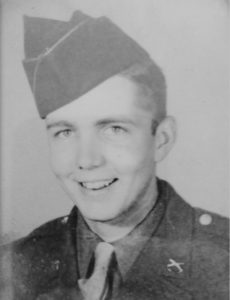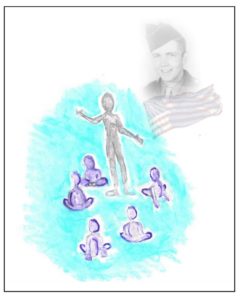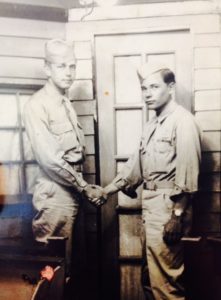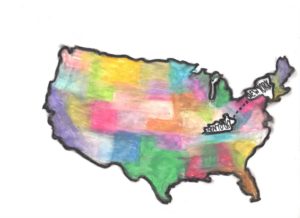Ralph Smith
Art Protector
Written and Illustrated by Sibya Honts
For the series A BOOK by ME - True Stories Written by Kids for Kids
 As we prepare to celebrate our freedom on the 4th of July, I think of all the great WWII veterans I’ve met thanks to A BOOK by ME. One in particular stands out in my mind. A man named Ralph Smith, originally from Kentucky, who had the unique experience of guarding the art stolen by the Nazis after it was recovered by the Allies’ Monuments, Fine Arts, and Archives program (also known as the Monuments Men).
As we prepare to celebrate our freedom on the 4th of July, I think of all the great WWII veterans I’ve met thanks to A BOOK by ME. One in particular stands out in my mind. A man named Ralph Smith, originally from Kentucky, who had the unique experience of guarding the art stolen by the Nazis after it was recovered by the Allies’ Monuments, Fine Arts, and Archives program (also known as the Monuments Men).
His young author Sibya Honts was so excited to preserve his story for readers but became ill in the process. The delay went on for months as Ralph patiently waited for her to recover. As she finished, I wrote a grant to put his storybook, along with other WWII books, in schools in Rock Island County Illinois. I used Ralph’s wartime experience in the needs statement.
 Meanwhile, his daughter Kathy contacted me saying they had called in hospice. I was at an art event when I ran into someone from the grant committee and she asked about Ralph. I told her the latest news and she said “as the grants are reviewed and those accepted are recommended for funding, I’ll let you know so you can order books and hopefully Ralph will get a chance to see a book before he passes away.” That’s how it happened that the first book off the printer went in an envelope and was mailed straight to Kathy.
Meanwhile, his daughter Kathy contacted me saying they had called in hospice. I was at an art event when I ran into someone from the grant committee and she asked about Ralph. I told her the latest news and she said “as the grants are reviewed and those accepted are recommended for funding, I’ll let you know so you can order books and hopefully Ralph will get a chance to see a book before he passes away.” That’s how it happened that the first book off the printer went in an envelope and was mailed straight to Kathy.
 When Ralph Smith passed away on April 27, 2016, his daughter Kathy was reading a copy of his book to him. She thought he passed away before she finished reading the last page but he turned his head to see what the artist drew. The piece of art with his photo in the clouds along with the United States flag. At the bottom of the page is the image of a teacher telling students about Ralph’s service.
When Ralph Smith passed away on April 27, 2016, his daughter Kathy was reading a copy of his book to him. She thought he passed away before she finished reading the last page but he turned his head to see what the artist drew. The piece of art with his photo in the clouds along with the United States flag. At the bottom of the page is the image of a teacher telling students about Ralph’s service.
That’s the last thing this great American hero saw before he left this earth. His service will not be forgotten thanks to author Sibya Honts.
– Deb Bowen, A BOOK by ME
 “I met Ralph Smith on November 11 (Veteran’s Day) in 2014. I was amazed to hear his story about guarding the art that was stolen by the Nazis during the war. After hearing his story, I learned more about the Monuments Men and their efforts during the war. If you have the opportunity to share the story of a World War II soldier, please do it. These stories should be told to the next generation.” — Author/Illustrator Sibya Honts
“I met Ralph Smith on November 11 (Veteran’s Day) in 2014. I was amazed to hear his story about guarding the art that was stolen by the Nazis during the war. After hearing his story, I learned more about the Monuments Men and their efforts during the war. If you have the opportunity to share the story of a World War II soldier, please do it. These stories should be told to the next generation.” — Author/Illustrator Sibya Honts
Art Protector, Ralph Smith’s Journey During WWII
Ralph Smith, Art Protector
Ralph Smith was a small-town boy from Burnside, Kentucky, where he lived with his parents and sister Jo Anne. At age eighteen, Ralph left his small-town roots behind, joining the army and heading for Europe to fight in World War II. He proudly sailed on the largest and fastest troop ship of the time, the RMS Queen Elizabeth, which carried 15,000 troops. It sped across the Atlantic Ocean from New York City to Scotland in six days. There, Ralph took a train to Southampton, England, where he boarded another ship to cross the English Channel to Le Havre, France. He took a train to Belgium, riding in a box car called a “40 and 8” because it could fit forty men or eight horses. He enjoyed a four-day break in Belgium before finally joining his division in the Netherlands.
During the war, the army censored letters the soldiers sent home, checking to be sure they did not contain information that might be useful to the enemy. Ralph couldn’t tell his family back home in Kentucky where he was or what he was doing. He was glad, when the war was over, finally to be allowed to tell them all about what he had done and where he had traveled. Until the war ended, his parents had no idea where their son was in Europe, but as long as they received letters from him, they knew he was safe. They were proud that their only son was fighting for freedom against tyranny.
 In a letter dated May 23, 1945, Ralph wrote to his parents, “Two weeks ago I was in Niedermarsberg one day, Brilon two days, and then me and three more GI’s with three Yugoslavs went to guard Count Graf Spee’s son’s castle. That is where I was when the war ended. We were supposed to have been guarding $10,000,000 worth of art there. I saw the Count and we gave him orders instead of him ordering us. We stayed in the castle and slept in nice beds with clean sheets. Walked on beautiful rugs and drank the Count’s champagne. Of course, [sic] I didn’t drink much but some of the guys did. I drank a little to celebrate the war being over. Don’t mind do you?”
In a letter dated May 23, 1945, Ralph wrote to his parents, “Two weeks ago I was in Niedermarsberg one day, Brilon two days, and then me and three more GI’s with three Yugoslavs went to guard Count Graf Spee’s son’s castle. That is where I was when the war ended. We were supposed to have been guarding $10,000,000 worth of art there. I saw the Count and we gave him orders instead of him ordering us. We stayed in the castle and slept in nice beds with clean sheets. Walked on beautiful rugs and drank the Count’s champagne. Of course, [sic] I didn’t drink much but some of the guys did. I drank a little to celebrate the war being over. Don’t mind do you?”
Why were Ralph and his buddies guarding ten million dollars’ worth of art? That’s an interesting story, and it has to do with Adolf Hitler and his unfulfilled aspirations. Hitler was an unsuccessful artist who had twice been denied admission to Vienna’s Academy of Fine Arts. Surviving examples of Hitler’s drawings show he had moderate talent, but he considered himself a connoisseur. While the Nazis took power, they plundered priceless art and cultural treasures from every area they invaded. This was done in a systematic manner, with organizations specifically created to determine which public and private collections would be most valuable.

After Hitler became Chancellor of Germany, one of his first acts was the “cleansing of the German culture,” which included burning books and labeling art “degenerate” if it did not conform to Nazi ideology. “Degenerate” art included all types of modern styles and the work of any artist who was seen as not being racially “Aryan.” Hitler made it a high priority to find and steal all degenerate art, and artists deemed degenerate were not allowed to paint.
The Nazis destroyed hundreds of famous, priceless, and irreplaceable paintings, drawings, sculptures and other artworks. Some that were kept were featured in a “degenerate art show” to try to fuel revulsion against the “perverse Jewish spirit.” Artists whose work was featured in the show included Marc Chagall, Henri Matisse, Pablo Picasso and Vincent van Gogh. After the exhibit ended, the art was either destroyed or sold at auction. A large amount of “degenerate art” was destroyed in a bonfire on July 27, 1942 in Paris, France.
Besides destroying and discrediting “degenerate” art, Hitler also collected priceless masterworks for his own museum. He intended to stuff the museum full of the pieces he stole during the war, essentially consolidating all of the surviving great art in Europe in a single museum that would honor National Socialism, or Nazism. What Ralph guarded was most likely some of this art Hitler wanted for his museum, which had been stolen by the Nazis and later recovered by the Monuments, Fine Arts and Archives program of the Allies.
The Monuments Men, as they were called, were a small group of mostly middle-aged men and a few women who interrupted their civilian careers as historians, architects, museum curators and professors to try to save irreplaceable items of art and culture. They found and recovered thousands of pieces of stolen art, traveling to areas the Nazis had occupied and searching out their art repositories. The art was often hidden in salt mines and caves. The Monuments Men also found vast amounts of gold and other precious materials the Nazis had plundered. The Allies collected the artworks and stored them at collection points until they could be returned to their rightful owners. Works of art that could be traced were returned to the countries from which they had been taken.
Another of Ralph’s adventures was driving the army trucks. He didn’t have a license and didn’t even know how to drive. That didn’t matter to his commanding officer. He was given a hand-written “license” and told to drive anyway. It was a crazy way to learn to drive, he said, and at one point, he sideswiped a streetcar in Germany. One of his driving assignments was to bring the bodies of dead American soldiers out of Germany into Belgium, so they could be buried on friendly foreign soil.

After the war, Ralph returned to Kentucky and was able to attend college, thanks to the GI Bill. The Bill provided financial assistance to servicemen, veterans and their families to help pay for education or to buy a home. Ralph attended the University of Kentucky and became a mechanical engineer. He met Louellen, a woman with three brothers who had all served in the U.S. Navy during the war. One of her brothers was killed on an aircraft carrier; his body was never recovered.
Ralph and Louellen married. Eventually, they moved to the Quad Cities area of Illinois and Iowa, where Ralph worked for American Air Filter in Moline, Illinois, and they raised their three children.
Ralph Smith passed away on April 27, 2016 while his daughter Kathy was reading a copy of his book to him. She informed him that local schools will receive his book because of a grant. His service will not be forgotten thanks to author Sibya Honts.
A BOOK by ME, a book series developed by Deb Bowen, empowers students to preserve history by telling the story of unsung heroes in our communities. For the young participants, it’s a guided cross-curricular project that gathers stories of people who do amazing things but have received little or no recognition. Students learn how to publish a picture book that is a primary source document with photographs and a biography.
Since 2003, Deb Bowen has been arranging meetings between students and individuals from the WWII generation. This intergenerational storytelling results in unique storybooks written and illustrated by kids for kids in the A BOOK by ME series. More about Deb Bowen >





